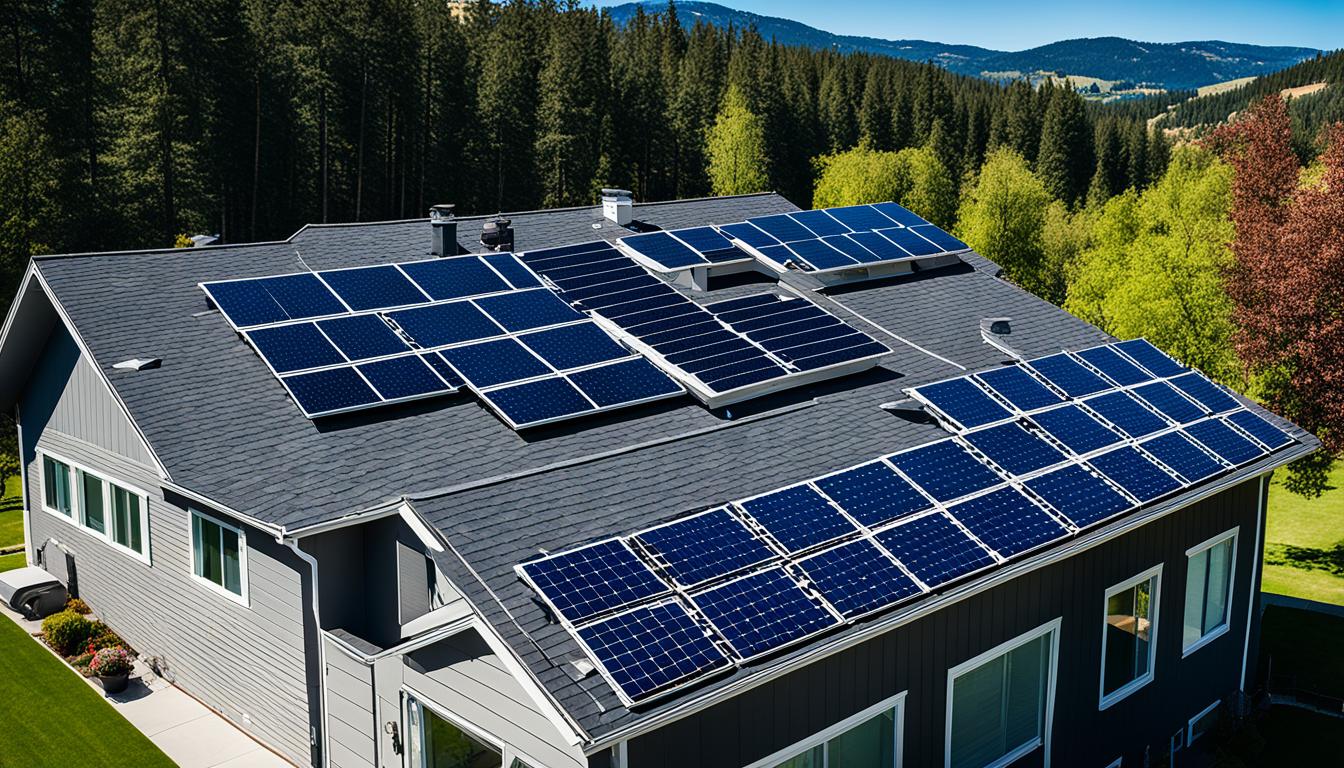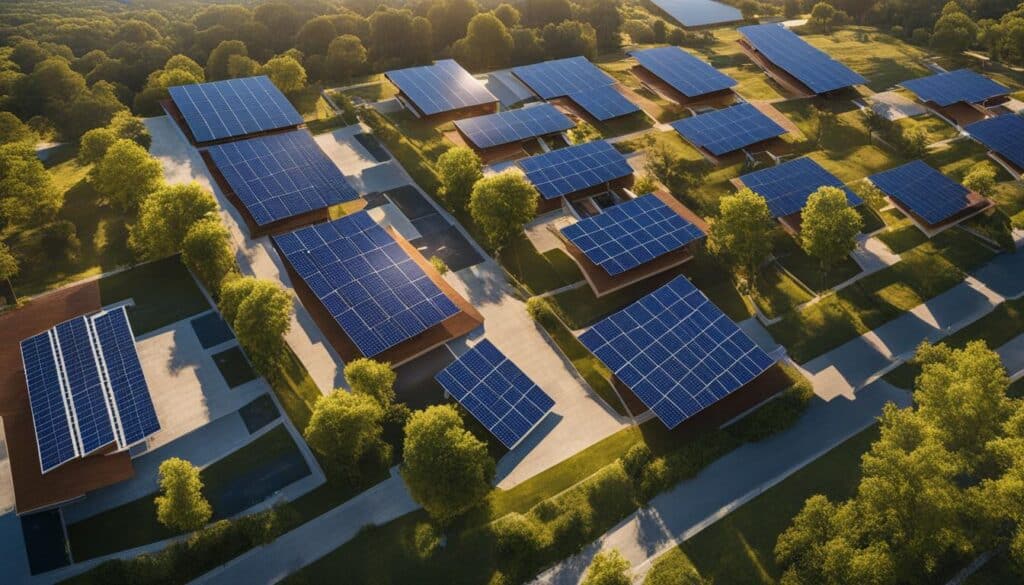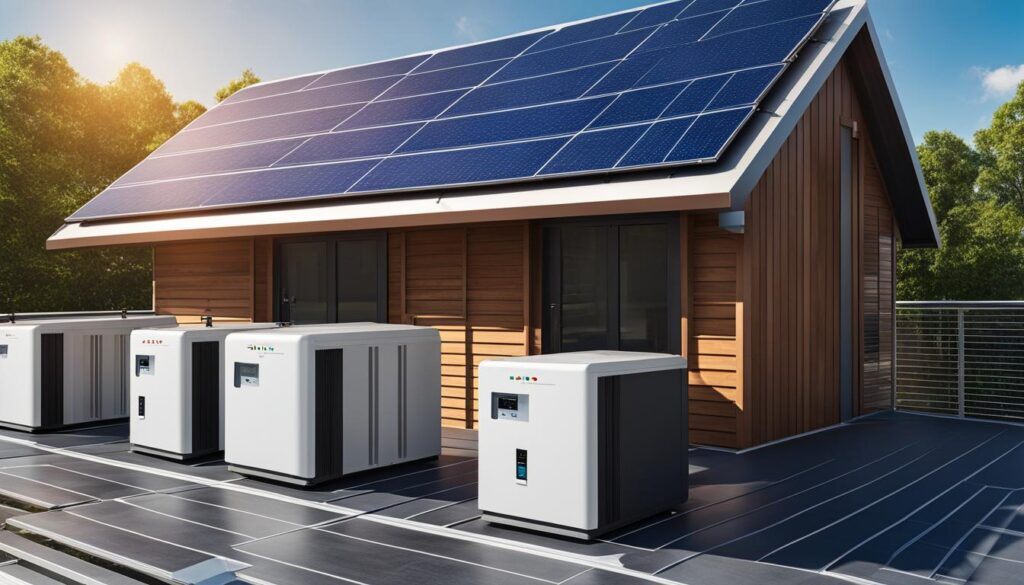
When it comes to harnessing the power of the sun, optimal solar panel placement is key to maximizing efficiency and getting the most out of your solar energy system. By strategically positioning your solar panels, you can significantly increase their energy output and reap the benefits of clean, renewable energy.
The angle and direction of your solar panels play a crucial role in their performance. While the pitch of your roof may determine the initial angle, customizing the angle and direction can lead to even greater electricity production. The primary source of solar radiation is direct sunlight, so the orientation of the panels affects their energy output. Ideally, one direction of your roof should face south (in the Northern Hemisphere) to receive maximum sun exposure. West-facing panels can also be beneficial as they align with peak electricity demand in the evenings.
It’s worth noting that the best angle for solar panels can vary depending on the season and location. However, a general range of 30 to 45 degrees is recommended for optimal performance. Adjusting the angle based on the season can help maximize sunlight absorption during winter and capture more sunlight in the summer.
To help you make informed decisions about solar panel placement, let’s delve deeper into the impact of solar panel orientation and angle, as well as other factors affecting solar panel efficiency.
Key Takeaways:
- Optimal solar panel placement is crucial for maximizing solar efficiency.
- Customizing the angle and direction of your panels can lead to increased electricity production.
- South-facing panels receive the maximum amount of direct sunlight, while west-facing panels align with peak electricity demand in the evenings.
- The angle of the panels should be adjusted based on the season and location.
- Factors such as solar panel orientation, angle, distance from south, and roof pitch can influence solar panel efficiency.
Common Mistakes to Avoid When Installing Solar Panels
While optimizing solar panel efficiency through proper placement, angle, and monitoring is essential, avoiding common mistakes during installation can significantly impact the overall performance of your solar energy system. Here are several key mistakes to be aware of:
1. Ignoring Local Regulations and Permits:
Before installing solar panels, it’s crucial to understand local regulations and obtain the necessary permits. Skipping this step can lead to fines, removal of the panels, or complications during the installation process. Research local zoning laws and requirements to ensure compliance.
2. Failing to Conduct a Site Assessment:
A thorough site assessment is essential for determining the best placement for solar panels. Factors such as shade from trees, nearby buildings, and roof orientation should be considered. Neglecting this assessment can result in poor energy production and a less efficient system.
3. Choosing the Wrong Equipment:
Investing in low-quality or incompatible solar panels, inverters, and mounting systems can negatively affect efficiency and longevity. Always opt for high-quality components from reputable brands to ensure optimal performance and reliability.
4. Poor Installation Practices:
Improper installation can lead to significant issues, including leaks, panel damage, or electrical problems. It’s advisable to hire experienced professionals for installation to ensure that all components are correctly installed and connected.
5. Neglecting Regular Maintenance:
Once your solar panels are installed, neglecting maintenance can hinder performance. Regularly clean the panels, check for debris, and inspect the system for any signs of wear or damage. Establishing a maintenance schedule can help keep your system operating at peak efficiency.
6. Not Considering Future Expansion:
If you plan to expand your solar system in the future, consider how the current installation will accommodate additional panels. Designing with future growth in mind can save you time and money later on.
7. Overlooking Energy Storage Options:
Many homeowners focus solely on solar panel installation and overlook the importance of energy storage systems, such as battery backup solutions. Incorporating energy storage allows you to maximize solar energy usage, providing power during outages and increasing your energy independence.
The Impact of Solar Panel Orientation and Angle
When it comes to maximizing solar efficiency, the orientation and angle of solar panels play a significant role. The orientation refers to the direction the panels face, while the angle relates to the tilt of the panels. Let’s explore how these factors can impact the performance of solar panels.
Solar Panel Orientation: In the Northern Hemisphere, south-facing panels receive the maximum amount of direct sunlight throughout the day, resulting in higher energy production. South-facing panels capture the sun’s rays more efficiently, maximizing the conversion of solar energy into electricity. West-facing panels can also be advantageous as they align with peak electricity demand in the evenings. However, east-facing panels produce slightly less energy, while north-facing panels are the least ideal due to reduced sun exposure.
Solar Panel Angle: The angle of the panels refers to the tilt at which they are installed. Adjusting the angle based on the season and location can optimize the energy output. Steeper angles are recommended in winter to clear snow and enhance sunlight absorption, maximizing energy production. On the other hand, flatter angles are more suitable for summer to capture a greater amount of sunlight. By adapting the angle, solar panels can make the most of available sunlight throughout the year.
Considering both the orientation and angle of solar panels is crucial for maximizing efficiency. South-facing panels with an appropriate tilt angle tend to yield the highest energy output. However, it’s important to note that the optimal orientation and angle may vary depending on geographical location and specific project requirements.
To illustrate the impact of solar panel orientation and angle, consider the following comparison:
| Orientation | Angle | Energy Output |
|---|---|---|
| South-Facing | Optimal | High |
| West-Facing | Optimal | Medium |
| East-Facing | Optimal | Lower |
| North-Facing | Optimal | Least Ideal |
As shown in the table above, south-facing panels with an optimal angle yield the highest energy output, while north-facing panels are the least ideal choice.
By considering solar panel orientation and angle, homeowners and businesses can optimize the efficiency of their solar power systems, maximize energy production, and reduce reliance on traditional energy sources.
Factors Affecting Solar Panel Efficiency
Several factors can significantly impact the efficiency of solar panels. Understanding these factors is essential for optimizing solar panel placement and maximizing energy output.
1. Solar Panel Placement Factors
The direction in which solar panels face plays a crucial role in their efficiency. Panels that face south generally receive the most direct sunlight, resulting in higher energy production. Panels facing southwest or southeast are slightly less efficient, followed by west- and east-facing panels. North-facing panels are the least ideal, as they receive the least amount of sunlight.
Alongside the orientation, the angle or tilt of the solar panels also affects their efficiency. Steeper roofs (higher degrees of slope) provide better angles for solar panel absorption. The ideal angle may vary depending on the season and location. In general, a range of 30 to 45 degrees is recommended for optimal energy production.
2. Regular Maintenance and Proper Installation
Regular maintenance by professionals is crucial for maximizing solar panel efficiency. Professionals can identify and address issues such as faulty wiring, damaged panels, or debris accumulation that may hinder optimal energy production.
Proper installation and the use of suitable components are also fundamental factors in solar panel efficiency. Quality installation ensures that the panels are securely fixed and correctly aligned for optimal exposure to sunlight. Using high-quality components, such as inverters and wiring, can help maximize the overall performance of solar panels.
Optimizing the placement of solar panels, along with regular maintenance and proper installation, can significantly enhance their efficiency, resulting in maximum energy output and long-term benefits.
3. Visual Appeal and Use of Tables
Visual appeal and the use of tables can enhance the presentation of information and provide a comprehensive overview of the factors affecting solar panel efficiency. Below is an example of a table highlighting the factors discussed in this section:
| Factor | Description |
|---|---|
| Solar Panel Placement | Optimal orientation and angle for maximum sunlight exposure |
| Regular Maintenance | Identification and resolution of issues that affect energy output |
| Proper Installation | Secure fixing and correct alignment of solar panels |

Maximizing Solar Power Efficiency through Energy Consumption Monitoring
Monitoring and reducing energy consumption are crucial steps in maximizing the efficiency of solar power systems. By closely tracking daily power usage and making necessary adjustments, homeowners can identify areas for improvement and reduce their reliance on traditional energy sources.
One effective way to monitor energy consumption is through the use of smart energy monitors. These devices provide real-time data on electricity usage, allowing homeowners to visualize and analyze their energy consumption patterns. By understanding when and where energy is being consumed the most, individuals can make informed decisions to optimize their energy usage.
Switching to energy-efficient light bulbs is another simple but impactful step towards reducing energy consumption. LED bulbs, for example, use significantly less energy than traditional incandescent bulbs and have a longer lifespan. Installing these energy-efficient bulbs throughout the home can result in substantial energy savings over time.
Additionally, implementing home automation systems can help regulate energy use and further reduce overall consumption. By automating tasks such as controlling lighting, heating, and cooling systems, homeowners can ensure that energy is only being used when needed. For instance, smart thermostats can adjust temperature settings based on occupancy, saving energy when the house is unoccupied.
“By optimizing energy usage, homeowners can maximize the benefits of their solar panels and reduce their dependence on the grid.”
Reducing energy consumption not only helps save costs but also maximizes the benefits of solar panel installations. By relying less on the conventional power grid, homeowners can maximize their solar power usage, leading to increased energy savings and a reduced carbon footprint.
Now, let’s take a look at an example of energy consumption monitoring and its impact on solar power efficiency:
| Month | Electricity Consumption (kWh) |
|---|---|
| January | 500 |
| February | 480 |
| March | 520 |
| April | 450 |
| May | 400 |
In the example above, homeowners actively monitored their energy consumption and made changes to reduce their usage. By implementing energy-efficient practices and home automation systems, they were able to achieve an average reduction of 20% in electricity consumption. This significant reduction allows their solar panels to generate a higher proportion of the energy required to power their home, effectively maximizing solar power efficiency.
By embracing energy consumption monitoring and implementing practices to reduce energy usage, homeowners can fully leverage the benefits of their solar panel systems. Not only does this help reduce reliance on traditional energy sources, but it also contributes to a more sustainable future for both individuals and the planet.
The Role of Battery Backup Systems in Solar Power Efficiency
Battery backup systems play a crucial role in maximizing solar power usage. They store excess solar energy for use during peak demand hours or when there is no sunlight. By incorporating battery backup systems, solar power users can make the most of their solar panels and increase their energy independence.
Maximizing Solar Power Usage with Battery Backup Systems
One of the key advantages of battery backup systems is their ability to store excess solar energy. This stored energy can be utilized during times when there is high energy demand or when the solar panels cannot generate electricity, such as during the night or on cloudy days. With a battery backup system in place, homeowners can ensure continuous access to clean, renewable energy, even in the absence of sunlight.
Moreover, battery backup systems enable homeowners to reduce their reliance on the traditional power grid. By having a stored power source, they can use the energy generated by their solar panels, reducing their electricity consumption from the grid. This not only lowers their carbon footprint but also helps offset the initial installation costs of the solar power system.
Increased Resilience during Outages
In addition to maximizing solar power efficiency, battery backup systems provide a reliable source of electricity during blackouts or grid failures. When the power grid goes down, battery backup systems automatically switch to provide power to the home, ensuring uninterrupted electricity supply. This can be particularly beneficial in areas prone to extreme weather events or unreliable power infrastructure.
During high energy demand periods, battery backup systems also help homeowners manage their electricity usage more efficiently. By relying on the stored energy in the batteries, they can reduce strain on the grid and minimize the likelihood of power outages during peak times.
Living Off-the-Grid and Achieving Self-Sufficiency
Battery backup systems offer the opportunity for homeowners to achieve self-sufficiency and live off-the-grid. By combining solar panels with battery storage, individuals can generate, store, and use their own electricity without relying on external power sources. This level of energy independence provides not only financial savings but also a sense of security and resilience.
Living off-the-grid means that homeowners have complete control over their energy usage and are less vulnerable to fluctuations in electricity prices or disruptions in the power supply. It also allows them to contribute to a sustainable future by reducing their reliance on fossil fuels and minimizing their carbon emissions.
Maximizing Solar Power Efficiency: Battery Backup System Benefits
By incorporating battery backup systems into their solar power setup, homeowners can maximize the efficiency of their solar panels. These systems store excess solar energy, provide power during blackouts, and reduce dependence on the traditional power grid. Furthermore, they enable individuals to achieve self-sufficiency, live off-the-grid, and contribute to a sustainable future.
Next, we will explore the impact of solar panel placement and the importance of optimal orientation and angle in maximizing solar power efficiency.

Conclusion
In conclusion, maximizing solar efficiency requires careful consideration of various factors, including optimal solar panel placement, orientation, and angle. By ensuring that the panels face south, homeowners can take advantage of direct sunlight, resulting in higher energy production. Additionally, west-facing panels can align with peak electricity demand in the evenings, further maximizing energy output.
Adjusting the angle of the panels based on the season and location is also crucial. Steeper angles in winter help clear snow and optimize sunlight absorption, while flatter angles in summer capture more sunlight. By implementing these adjustments, homeowners can make the most of their solar panels throughout the year.
To enhance solar power efficiency, regular monitoring and reduction of energy consumption are key. By tracking daily power usage and identifying areas for improvement, homeowners can reduce their reliance on traditional energy sources. Incorporating energy-efficient light bulbs and home automation systems further contribute to energy conservation and maximize the benefits of solar panels.
In addition, integrating battery backup systems plays a vital role in optimizing solar power usage. These systems store excess energy for use during peak demand hours or when sunlight is unavailable, providing power during blackouts and reducing dependence on the grid. By incorporating batteries, homeowners can achieve self-sufficiency and further increase their energy independence.
In summary, by considering optimal panel placement, adjusting orientation and angle, monitoring energy consumption, and utilizing battery backup systems, homeowners can maximize solar power efficiency. This not only leads to financial savings but also contributes to a sustainable future by reducing carbon footprints and promoting renewable energy sources.
FAQ
What factors should I consider for optimal solar panel placement?
Factors to consider for optimal solar panel placement include the angle and direction of the panels, the pitch of the roof, and the location of the panels in relation to the sun.
How does the orientation of solar panels affect their energy output?
The orientation of solar panels refers to the direction they face, with south-facing panels receiving the maximum amount of direct sunlight throughout the day, leading to higher energy production. West-facing panels can be advantageous for matching peak electricity demand in the evenings, while east-facing panels produce slightly less energy. North-facing panels are the least ideal due to reduced sun exposure.
What is the ideal angle for solar panels?
The ideal angle for solar panels varies depending on the season and location, but typically it ranges between 30 to 45 degrees. Steeper angles are recommended in winter to clear snow and maximize sunlight absorption, while flatter angles are better for summer to capture more sunlight.
What factors can affect the efficiency of solar panels?
Several factors can influence the efficiency of solar panels, including the distance from south, the panel’s direction (e.g., southwest, southeast, west, east, or north-facing), and the roof pitch. Regular maintenance and proper installation also contribute to the overall performance of solar panels.
How can I maximize solar power efficiency through energy consumption monitoring?
By using smart energy monitors, homeowners can track daily power consumption, identify areas for improvement, and reduce their reliance on traditional energy sources. Switching to energy-efficient light bulbs and installing home automation systems can also help regulate energy use and reduce overall consumption.
What is the role of battery backup systems in solar power efficiency?
Battery backup systems store excess solar energy for use during peak demand hours or when there is no sunlight. They provide power during blackouts and high energy demand periods, reducing reliance on the traditional grid and offsetting installation costs. Battery backup systems also help homeowners achieve self-sufficiency and live off-the-grid.






